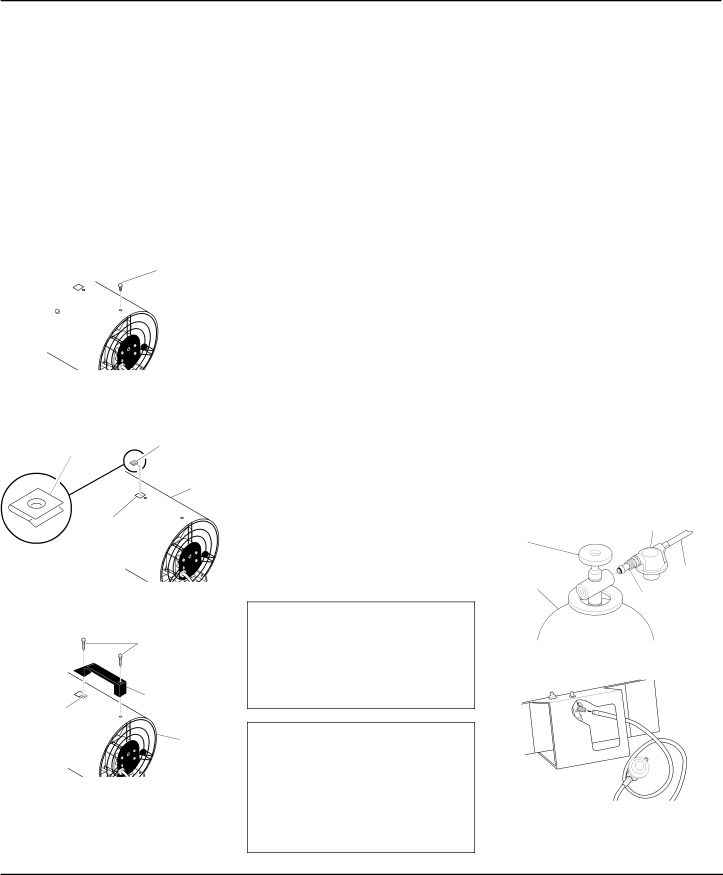
30,000 BTU/Hr
PROPANE CONSTRUCTION HEATER
ASSEMBLY
1.Remove screw from top of fan guard. Discard screw.
2.Insert nut clip (provided with handle) with flat side facing up through slot in top of shell. Align holes in nut clip with screw hole behind slot in top of shell. (see Figure 4).
3.Place handle over hole and clip. In- sert two screws (provided with handle) through handle and tighten into shell. Make sure rear screw goes through shell and into fan guard. Tighten screws firmly.
Remove
Screw
Figure 3 - Removing Screw from Top of Fan Guard
Flat Side Facing Up | Nut Clip |
Shell
Slot
Figure 4 - Installing Nut Clip
Screws
Handle
Nut Clip
Rear of
Heater
Figure 5 - Attaching Handle
PROPANE SUPPLY
Propane gas and propane tank(s) are to be furnished by the user.
Use this heater only with a propane vapor withdrawal supply system. See Chapter 5 of the Standard for Storage and Handling of Liquefied Petroleum Gas, ANSI/NFPA 58 and/or CAN/CGA B149.2. Your local library or fire department will have this booklet.
The amount of propane gas ready for use from propane tanks varies. Two factors de- cide this amount:
1.The amount of propane gas in tank(s)
2.The temperature of tank(s)
This heater is designed to operate with a minimum
Average Temp (°F) | No. Of Tanks |
At Tank Location | |
40° | 1 |
32° | 1 |
20° | 1 |
10° | 1 |
0° | 1 |
2 | |
2 |
INSTALLATION
![]() WARNING: Review and un- derstand the warnings in the Safety Information section, page
WARNING: Review and un- derstand the warnings in the Safety Information section, page
2.They are needed to safely op- erate this heater. Follow all local codes when using this heater.
![]() WARNING: Test all gas pip- ing and connections for leaks after installation or servicing. Never use an open flame to check for a leak. Apply a mixture of liquid soap and water to all joints. Bubbles forming show a leak. Correct all leaks at once.
WARNING: Test all gas pip- ing and connections for leaks after installation or servicing. Never use an open flame to check for a leak. Apply a mixture of liquid soap and water to all joints. Bubbles forming show a leak. Correct all leaks at once.
1.Provide propane supply system (see Propane Supply).
2.Connect POL fitting on hose/regulator assembly to propane tank(s). Turn POL fitting counterclockwise into threads on tank. Tighten firmly using wrench. IMPORTANT: Position regulator so that hose leaving the regulator is in a horizontal position (see Figure 6). This places the regulator vent in the proper position to protect it from the weather.
3.Connect hose to valve inlet (see Figure 7). Tighten firmly using a wrench.
IMPORTANT: Use extra hose or pip- ing if needed. Install extra hose or pip- ing between hose/regulator assembly and propane tank. You must use the regulator supplied with heater.
4.Open propane supply valve on propane tank(s) slowly. Note: If not opened slowly,
5.Check all connections for leaks. Apply mixture of liquid soap and water to gas joints. Bubbles forming show a leak that must be corrected.
6.Close propane supply valve.
Propane Supply | Regulator |
| |
Valve |
|
Propane | Hose |
| |
Tank | POL Fitting |
|
Figure 6 - Regulator Position
Figure 7 - Hose and Inlet Connector
4 | 104163 |
